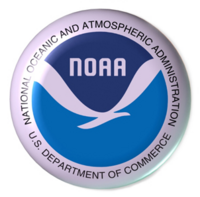National Oceanic and Atmospheric Administration
The National Oceanic and Atmospheric Administration is a scientific agency within the United States Department of Commerce focused on the conditions of the oceans and the atmosphere.[1]
NOAA works toward its mission through these seven major organizations in addition to several special program units:[2]
- NOAA National Weather Service
- National Environmental Satellite, Data, and Information Service
- National Marine Fisheries Service
- NOAA Ocean Service
- NOAA Research
- Office of Marine and Aviation Operations
- Office of Oceanic and Atmospheric Research
- Program Planning and Integration
National Weather Service
The National Weather Service (NWS) is responsible for providing "weather, hydrologic, and climate forecasts and warnings for the United States, its territories, adjacent waters and ocean areas, for the protection of life and property and the enhancement of the national economy."[3] This is done through national and regional centers, and more than 120 local weather forecast offices. They are charged with issuing weather forecasts, severe weather advisories, watches, and warnings on a daily basis.
The NWS issues more than 734,000 weather and 850,000 river forecasts, and more than 45,000 severe weather warnings annually. The NWS operates NEXRAD, a nationwide network of Doppler weather radars which can detect precipitation (rainfall). Many of their products are broadcast on NOAA Weather Radio, a network of radio transmitters that broadcasts weather forecasts, severe weather statements, watches and warnings 24 hours a day.
World Area Forecast System and World Area Forecast Centers
The World Area Forecast System (WAFS) was established in 1982 by the International Civil Aviation Organization (ICAO) and was defined as a worldwide system by which World Area Forecast Centers (WAFC) provide aeronautical meteorological en-route forecasts in uniform standardized formats. The ICAO also defined a WAFC as a meteorological center designated to prepare and issue significant weather forecasts and upper-air forecasts in digital form on a global basis.[4]
There are only two ICAO-sponsored WAFCs, one in the United States and one in the United Kingdom. The two WAFCs are referred to as the Washington WAFC and the London WAFC respectively.[4]
The Washington WAFC is composed of two components: the Aviation Weather Center (AWC) in Kansas City, Missouri; the National Centers for Environmental Prediction (NCEP) central operations in Camp Springs, Maryland; and the Telecommunications Operations Center (TOC) at the National Weather Service headquarters in Silver Spring, Maryland.[4]
Office of Oceanic and Atmospheric Research (OAR)
The Office of Oceanic and Atmospheric Research (OAR)is part of NOAA's research network consisting of 7 internal research laboratories, extramural research at Sea Grant universities, six undersea research centers, research grants funded by the Climate Program Office, and 13 cooperative institutes with various universities.[5]
The research conducted in the OAR laboratories and by the extramural programs focuses on environmental subjects such as hurricanes and tornados, solar flares, the ozone layer, air pollution transport and dispersion, El Niño/La Niña events, ocean currents, fisheries productivity and coastal ecosystems.[5]
Air Resources Laboratory
The Air Resources Laboratory (ARL) is one of the laboratories in the Office of Oceanic and Atmospheric Research.[6] It develops climate and air quality models including the transport, dispersion and removal of air pollutants from the ambient atmosphere. The specific goal of the ARL is to improve the prediction of trends, dispersion of air pollutant plumes, air quality, atmospheric deposition, and related variables.
The ARL provides tools and information to improve prediction of the atmospheric transport of toxic chemicals and other hazardous materials. The ARL also develops, improves, and tests dispersion models and other tools for air quality and emergency response applications, including volcanic eruptions, forest fires, nuclear accidents, and homeland security incidents.<ref>Atmospheric Transport and Dispersion] From the NOAA website.
References
- ↑ National Oceanic and Atmospheric Administration. Department of Commerce. Retrieved on 2007-11-17.
- ↑ NOAA Organizations. Department of Commerce. Retrieved on 2008-01-30.
- ↑ National Weather Service Mission Statement
- ↑ 4.0 4.1 4.2 World Area Forecast System
- ↑ 5.0 5.1 About NOAA research. Department of Commerce. Retrieved on 2008-01-30.
- ↑ Air Resources Laboratory. Department of Commerce. Retrieved on 2008-01-30.

